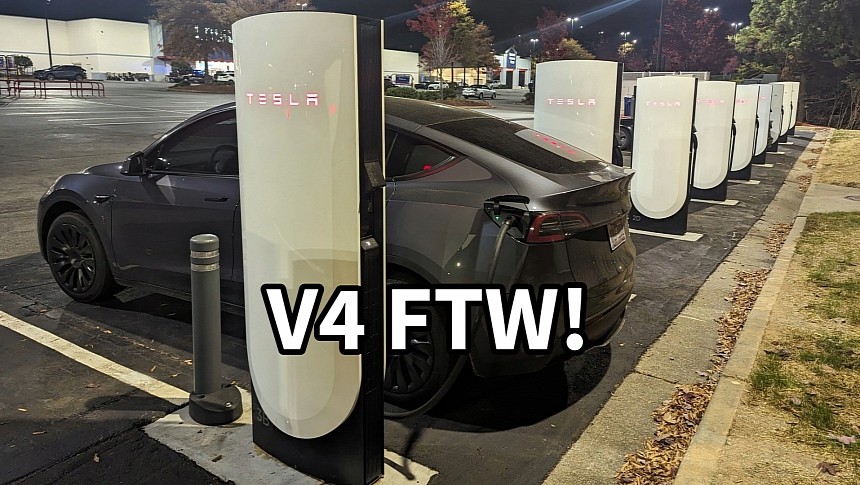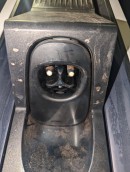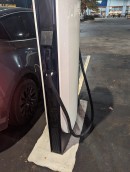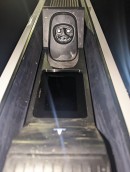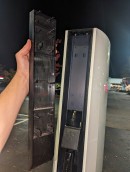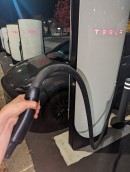In the past months, Tesla opened the first Supercharger V4 stations in the US, and owners are already using them. The upgraded chargers offer certain advantages, but there are also drawbacks that Tesla needs to address in future deployments.
In March, Tesla installed the first Supercharger V4 chargers in the Netherlands. The upgraded dispensers are theoretically capable of outputting 1,000 volts and over 600 amps. This means the V4 chargers have at least double the power capability of the V3 stalls. The new stalls are also coming to the Supercharger stations in the US. The first location fitted with V4 chargers opened in Sparks, Nevada, just a couple of weeks ago.
As the first stations have opened for business, Tesla owners have already used them and made an opinion about them. Supercharger V4 stations have a different layout, which should allow more flexibility when charging different non-Tesla EVs, while the stalls have longer cords. Some of the changes have been appreciated, although not everything is perfect with the new hardware.
Logan (@loganr519), who shared his experience on Elon Musk's social media platform, X, noted that the chargers are rated for 1,000 volts and 610 amps. Still, they are using the old 500-volt, 387 kVA power cabinets. This is no different from the V4 Superchargers in Europe, which also use the old power cabinets. However, as Tesla prepares to deliver the first Cybertruck units, it will need 1,000-volt Superchargers to make the most out of the electric pickup, which uses an 800-volt electrical system.
The most obvious thing about the new station is that charger stalls are positioned between the charging spots. Previously, V3 chargers were behind every spot, which made them prone to being hit by the car when an inattentive driver backed up. The new setup seems like an advantage, but the downside is that getting out of the back seats is now more difficult, as the rear doors would not open fully because of the stalls.
After only a few weeks of use, the chargers don't look in very good shape, and Logan considers them lower quality than V3 chargers. The latching mechanism that was supposed to hold the plug attached doesn't do its job very well. Logan found a cable lying on the ground when he arrived. The black plastic ornaments on the stalls also felt cheap and flimsy, with one falling off when he touched it.
The longer cable is an advantage for drivers of EVs with a different charge port layout because it allows them to reach further with the plug. On the other hand, the cables get twisted and kinked, which might shorten their service life. On the plus side, the cord feels light and flexible, and it's easy to hold with only one hand. This is impressive, considering the cable must have active cooling lines inside.
The new Supercharger V4 stations also offer pull-through spots for EVs towing a trailer, although there was only one at the station Logan visited. This seems like an oversight with the Cybertruck launch imminent and the stations opening up to non-Tesla EVs. However, with more stations converted to V4 and new ones being built, there should be enough charging opportunities for everybody.
As the first stations have opened for business, Tesla owners have already used them and made an opinion about them. Supercharger V4 stations have a different layout, which should allow more flexibility when charging different non-Tesla EVs, while the stalls have longer cords. Some of the changes have been appreciated, although not everything is perfect with the new hardware.
Logan (@loganr519), who shared his experience on Elon Musk's social media platform, X, noted that the chargers are rated for 1,000 volts and 610 amps. Still, they are using the old 500-volt, 387 kVA power cabinets. This is no different from the V4 Superchargers in Europe, which also use the old power cabinets. However, as Tesla prepares to deliver the first Cybertruck units, it will need 1,000-volt Superchargers to make the most out of the electric pickup, which uses an 800-volt electrical system.
The most obvious thing about the new station is that charger stalls are positioned between the charging spots. Previously, V3 chargers were behind every spot, which made them prone to being hit by the car when an inattentive driver backed up. The new setup seems like an advantage, but the downside is that getting out of the back seats is now more difficult, as the rear doors would not open fully because of the stalls.
After only a few weeks of use, the chargers don't look in very good shape, and Logan considers them lower quality than V3 chargers. The latching mechanism that was supposed to hold the plug attached doesn't do its job very well. Logan found a cable lying on the ground when he arrived. The black plastic ornaments on the stalls also felt cheap and flimsy, with one falling off when he touched it.
The longer cable is an advantage for drivers of EVs with a different charge port layout because it allows them to reach further with the plug. On the other hand, the cables get twisted and kinked, which might shorten their service life. On the plus side, the cord feels light and flexible, and it's easy to hold with only one hand. This is impressive, considering the cable must have active cooling lines inside.
The new Supercharger V4 stations also offer pull-through spots for EVs towing a trailer, although there was only one at the station Logan visited. This seems like an oversight with the Cybertruck launch imminent and the stations opening up to non-Tesla EVs. However, with more stations converted to V4 and new ones being built, there should be enough charging opportunities for everybody.
Finally got to test out one of the first V4 station in the USA! This site was field listed by ETL. The posts are 1000V 610A 100% rated! They are still using the old 500V 387kVA power cabinets. Here are some of my thoughts... pic.twitter.com/UxWP4S5jZD
— Logan ????????? (@loganr519) November 10, 2023
